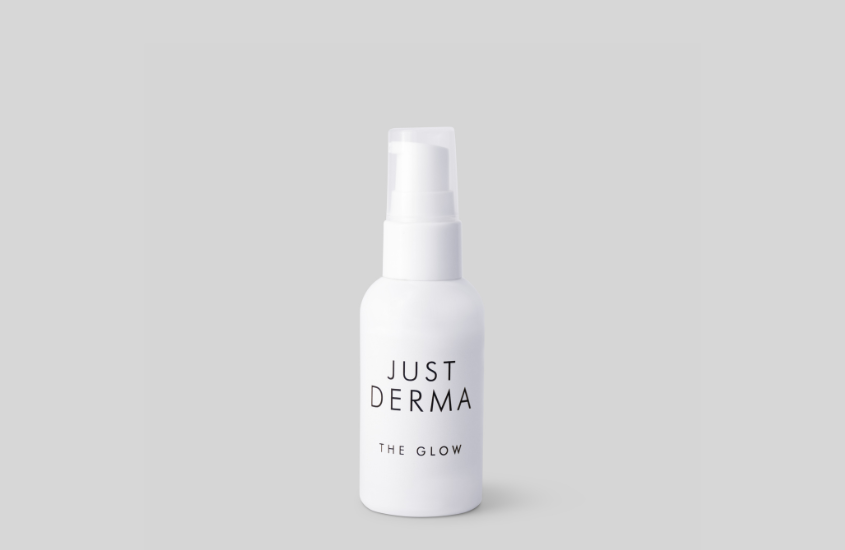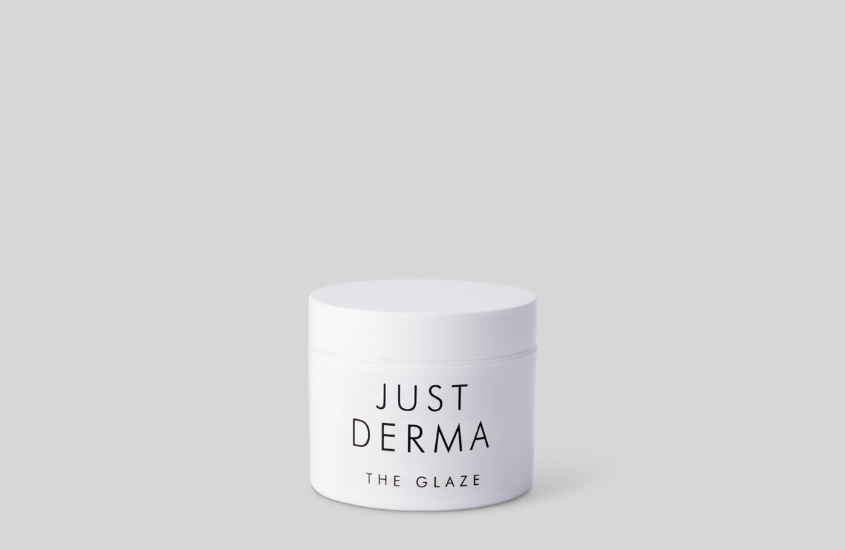The Glaze full ingredient list and definition
Ingredients: Aloe Barbadensis Leaf Juice, Aqua (Water), Hyaluronic Acid, Sodium Acetylated Hyaluronate, Sodium Hyaluronate, Squalane, Polyglutamic Acid, Ceramide NP, Ceramide NS, Ceramide AP, Ceramide EOP, Ceramide EOS, Bakuchiol, Glyceryl Stearate, Cetyl Alcohol, Hyaluronate Crosspolymer, Hydrolyzed Sodium Hyaluronate, Stearic Acid, Glycerin, Sunflower Oil, Panthenol (Vitamin B5), Jojoba Seed Oil, Irish Moss Extract, Spirulina Maxima Extract, Gotu Kola Extract, Xanthan Gum, Ethylhexylglycerin, Phenoxyethanol.
Aloe Barbadensis Leaf Juice
Aloe barbadensis leaf juice is the juice extracted from the leaves of the aloe plant. It is commonly used for its soothing properties and skin-calming effects. Aloe barbadensis leaf juice is also used as a film former, humectant, and skin-conditioning agent (emollient).
Aqua
Aqua (also simply known as water) is the most frequently used ingredient. Water’s primary function in skin care formulas is as a solvent.
Hyaluronic Acid
Component of skin tissue. Synthetic variations are used in skin care products to function as a superior skin-replenishing ingredient. Hyaluronic acid has restorative abilities and can boost skin’s moisture content, soothe, and defend against moisture loss. It is capable of holding up to 1,000 times its own weight in water, making it an optimal hydrator for all skin types.
Sodium Acetylated Hyaluronate
Sodium acetylated hyaluronate is the acetyl ester of sodium hyaluronate, where some of hyaluronic acid’s hydroxyl groups are replaced with acetyl groups. This swap in groups allows for enhanced bioavailability and better stability, increasing benefits since this allows for penetration deeper into skin and lets the ingredient reach its destination sooner.
Sodium Hyaluronate
Sodium hyaluronate is the salt form of the skin-replenishing ingredient hyaluronic acid. It shares the same benefits as hyaluronic acid, including its remarkable ability to help skin retain a lot of moisture. The chief difference between hyaluronic acid and sodium hyaluronate is that sodium hyaluronate is more bioavailable - meaning skin more readily absorbs it than hyaluronic acid. This doesn’t necessarily mean it’s better than hyaluronic acid, merely that many skin care products contain both forms, so your skin sees maximum benefits. Both hyaluronic acid and sodium hyaluronate are available in different molecular weights for multi-level results.
Polyglutamic Acid
Polyglutamic acid is a water-soluble humectant capable of attracting and holding water within skin and on its surface. It’s a polymer of the amino acid glutamic acid that’s made via bacterial fermentation using various types of skin-friendly Bacillus, a gram-positive, rod-shaped bacteria. The resulting ingredient has been shown to rival hydrating results of hyaluronic acid.
Squalane
Squalane is an emollient that helps prevent moisture loss and restores suppleness to skin. It is also a source of beneficial fatty acids that replenish skin. Despite its sebum-like nature, squalane feels surprisingly lightweight and non-greasy. Squalane can also help strengthen skin’s barrier to help it be less prone to sensitivity and reactiveness. Squalane also functions as an antioxidant. The antioxidant benefit of squalane also helps it protect skin’s oil from what’s known as lipid peroxidation, a process that damages skin’s surface and deeper in the pore lining where oil originates.
Ceramide NP
Ceramide NP is one of several types of ceramides found naturally in skin. It plays a critical role as a major component of skin’s outer layers (healthy skin is generally composed of 50% ceramides, many of which are of the NP variety). “N” stands for the type of normal fatty acid correlated to this ingredient and “P” stands for its phytosphingosine base. Research shows skin care products containing ceramide NP can help improve the look and feel of dry or dehydrated skin thanks to its water retention properties. Ceramide NP has also been shown to reinforce skin’s barrier strength to better resist external stressors. Overall, it contributes to supple, resilient, hydrated skin.
Ceramide NS
Ceramide NS in particular is a sphingosine-based ceramide, which when included in skin care formulas, helps skin produce more of its own ceramides. This helps skin better retain its moisture, while simultaneously strengthening its barrier against external stimuli.
Ceramide AP
Ceramide AP belongs to a larger group of ceramides that are naturally occurring, long chains of lipids (fats) in skin. Skin’s general composition of ceramides is around 50% and of that, 16% of those ceramides are of the AP variety. Decreased levels of ceramides have been shown to weaken the barrier, making skin more vulnerable to external stressors. More specifically, a decline in ceramide AP has been linked to skin conditions such as eczema and psoriasis.
Ceramide EOP
Ceramide EOP belongs to a larger group of ceramides that are found naturally in skin as long chains of lipids (fats). As a skin care ingredient, topical application of ceramide EOP can strengthen skin’s barrier against external stimuli.
Ceramide EOS
Ceramide EOS (formerly known as ceramide 1) belongs to a larger group of ceramides that are found naturally in skin as long chains of lipids (fats). Healthy skin is made up of 50% ceramides, but when those ceramides decrease, skin’s barrier becomes weaker, making it more vulnerable to external stressors and dehydration. As a skin care ingredient, topical application of ceramide EOS can step in to help fill this gap and replenish skin’s barrier, so it is better able to defend itself from external stimuli.
Bakuchiol
Research has shown that bakuchiol has a range of anti-aging benefits for skin. It can reduce the appearance of fine lines and wrinkles, help restore firmness, refine skin texture and even out skin tone. Bakuchiol helps to calm skin making it a good option for those whose skin shows signs of sensitivity.
Glyceryl Stearate
Glyceryl stearate is a mixture of portions of glycerin and stearic acid. Glyceryl stearate functions as an emollient, surfactant, and emulsifier in skin care products.
Cetyl Alcohol
Cetyl alcohol is a gentle fatty alcohol used as an emollient (moisturizing ingredient), emulsifier, thickener, and carrying agent for other ingredients.
Sodium Hyaluronate Crosspolymer
A modified form of skin-replenishing hyaluronic acid attached to a polymer structure that keeps it within skin's uppermost layers longer, allowing for enhanced hydration.
Hydrolyzed Sodium Hyaluronate
Hydrolyzed sodium hyaluronate is sodium hyaluronate (the salt form of hyaluronic acid) that has gone through the process of hydrolysis. This process involves changing an ingredient from one form to another by the addition of water or enzymes. In this case, it results in a form of sodium hyaluronate with a lower molecular weight, meaning it can more readily penetrate skin.
Stearic Acid
Stearic acid is a versatile fatty acid that functions as an emollient, emulsifier, cleansing and texture-enhancing ingredient in skin care formulas.
Glycerin
Glycerin is a skin-replenishing and skin-restoring humectant, meaning it is a substance found naturally in skin, helping to establish normal balance and hydration. It’s one of the many substances in skin that helps maintain a healthy look and feel, defending against dryness and working to maintain skin’s moisture level. Essentially, glycerin is a master at hydration, and works best when combined with other replenishing and emollient ingredients.
Sunflower Oil
Sunflower seed oil is a non-volatile, non-fragrant plant oil used as an emollient in cosmetics. Sunflower seed oil’s 60% (on average) linoleic acid content has the ability to help replenish, strengthen, and soothe skin. This oil also contains other beneficial fatty acids skin can use, including oleic, palmitic, stearic, and a small amount of omega-3 linolenic acid. Sunflower seed oil is particularly beneficial for dry, dehydrated, or environmentally compromised skin because its linoleic acid content helps skin synthesize its own lipids (fats), including ceramides, visibly repairing its barrier and leading to smoother, healthier-looking skin. Sunflower seed oil also has a natural calming effect on skin, so can be helpful for reducing signs of skin stress or irritation.
Panthenol (Vitamin B5)
Panthenol is a popular humectant in personal care products due to its ability to attract and hold moisture. When topically applied, it converts to pantothenic acid, which is a naturally occurring substance within the body.
Jojoba Seed Oil
Jojoba seed oil is a non-fragrant emollient extracted from the seeds of a perennial shrub. It has been shown to enhance skin’s restorative properties and can also provide topical skin-soothing benefits. Jojoba seed oil is a rich source of numerous fatty acids and antioxidants.
Irish Moss Extract
Irish Moss is a type of seaweed that’s a rich source of many nutrients for skin, including the pigment beta-carotene and potent antioxidants zeaxanthin, lutein, which help protect skin from the visible effects of blue light exposure. The natural polysaccharides, peptides, and amino acids in Irish Moss also help skin to stay hydrated; meanwhile, the numerous antioxidants help shield skin from damaging airborne pollutants. Irish Moss contains a compound known as carrageenan, which forms a flexible film on skin that offers further defense against environmental stressors.
Spirulina Maxima Extract
Spirulina Maxima extract is the extract from a type of blue-green algae. Research shows it has potent antioxidant and potential calming abilities.
Gotu Kola Extract
Gotu Kola is a perennial herb that grows primarily in Asia. For years, it’s had both culinary and medicinal uses. It has multiple benefits for skin thanks to its active compounds, including madecassoside, which serves as an antioxidant. Gotu Kola has been shown to have potent antioxidant properties and to be a rich source of amino acids, and there’s additional research showing that it’s a good hydrating ingredient to soothe upset or compromised skin.
Xanthan Gum
Xanthan gum in skin care is used as a thickening agent, texture enhancer, and to stabilize emulsions, which is a general term for mixtures of unlike substances such as oil and water.
Ethylhexylglycerin
Ethylhexylglycerin is a synthetic skin-softening agent. Ethylhexylglycerin is used as a preservative and carrier/suspending agent that boosts the efficacy of other preservatives such as phenoxyethanol. It has been shown to have mild humectant properties leading to improved skin hydration without a sticky feel.
Phenoxyethanol
Phenoxyethanol is a widely used synthetic preservative with global approval for use in rinse-off or leave-on cosmetic products.


